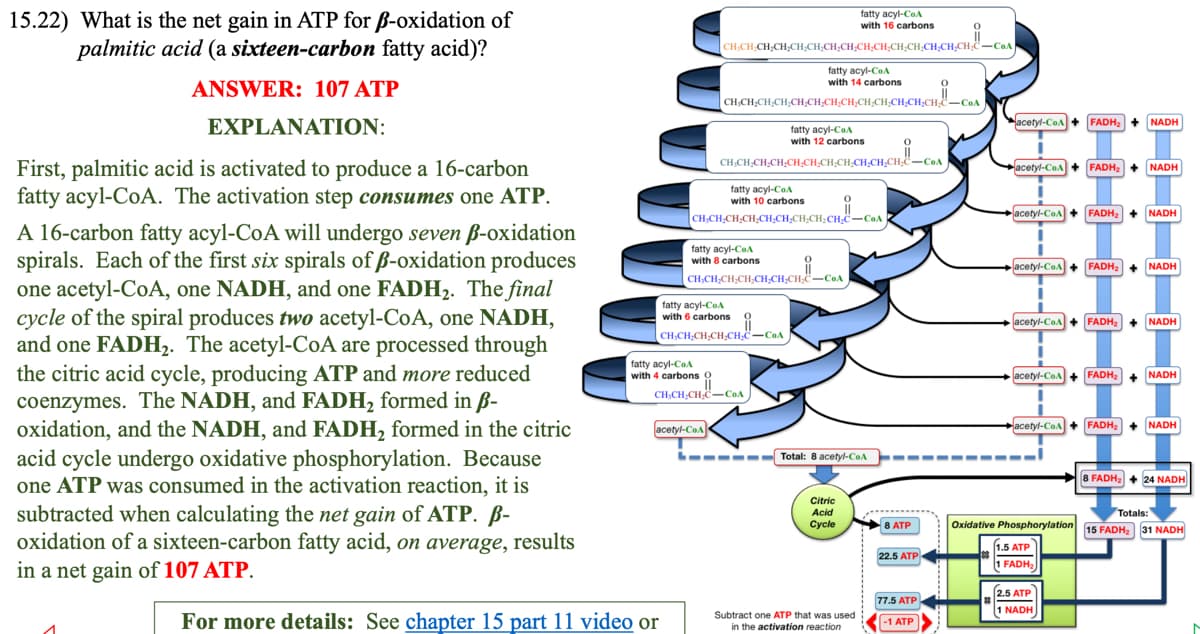What is the net gain in ATP for ß-oxidation of palmitic acid (a sixteen-carbon fatty acid)?
What is the net gain in ATP for ß-oxidation of palmitic acid (a sixteen-carbon fatty acid)?
Biochemistry
9th Edition
ISBN:9781319114671
Author:Lubert Stryer, Jeremy M. Berg, John L. Tymoczko, Gregory J. Gatto Jr.
Publisher:Lubert Stryer, Jeremy M. Berg, John L. Tymoczko, Gregory J. Gatto Jr.
Chapter1: Biochemistry: An Evolving Science
Section: Chapter Questions
Problem 1P
Related questions
Question
I don't understand it. Can you help me? Can u help me to explain this to me, please?

Transcribed Image Text:15.22) What is the net gain in ATP for B-oxidation of
palmitic acid (a sixteen-carbon fatty acid)?
ANSWER: 107 ATP
EXPLANATION:
First, palmitic acid is activated to produce a 16-carbon
fatty acyl-CoA. The activation step consumes one ATP.
A 16-carbon fatty acyl-CoA will undergo seven ß-oxidation
spirals. Each of the first six spirals of ß-oxidation produces
one acetyl-CoA, one NADH, and one FADH₂. The final
cycle of the spiral produces two acetyl-CoA, one NADH,
and one FADH₂. The acetyl-CoA are processed through
the citric acid cycle, producing ATP and more reduced
coenzymes. The NADH, and FADH₂ formed in ß-
oxidation, and the NADH, and FADH₂ formed in the citric
acid cycle undergo oxidative phosphorylation. Because
one ATP was consumed in the activation reaction, it is
subtracted when calculating the net gain of ATP. ß-
oxidation of a sixteen-carbon fatty acid, on average, results
in a net gain of 107 ATP.
fatty acyl-CoA
with 16 carbons
CHÍCH CHỊCHỊCHÍCHÍCHÍCH CHÍHACHCHANH CÁCH CỦA
fatty acyl-CoA
with 4 carbons
fatty acyl-CoA
with 14 carbons
CHÍCHÍCH-CH-CHCHCH;CH;CHCH-CH;CH,CH–CA
fatty acyl-CoA
with 10 carbons
CHÍCHÍCH CHCH_CH,CH,CH,CH C–CaA
For more details: See chapter 15 part 11 video or
fatty acyl-CoA
with 8 carbons
CHCHCH,CH,CH,CH,CH,C—CoA
fatty acyl-CoA
with 6 carbons
CH,CH-CH:CH-CH₂C-Cas
acetyl-CoA
fatty acyl-CoA
with 12 carbons
CH,CH,CH,CH,CH,CH,CH_CH,CH,CH,CH,C–CoA |
CH₂CH₂CH₂C-COA
-‒‒‒‒‒ Total: 8 acetyl-CoA
Citric
Acid
Cycle
Subtract one ATP that was used
in the activation reaction
8 ATP
22.5 ATP
0
77.5 ATP
-1 ATP
acetyl-CoA FADH₂
acetyl-CoA FADH₂ + NADH
NADH
acetyl-CoA FADH₂ NADH
acetyl-CoA FADH₂ + NADH
acetyl-CoA + FADH₂ + NADH
i
acetyl-CoA + FADH₂ NADH
acetyl-CoA FADH₂ + NADH
1.5 ATP
1 FADH₂
Totals:
Oxidative Phosphorylation 15 FADH₂ 31 NADH
2.5 ATP
1 NADH
8 FADH₂ + 24 NADH
Expert Solution
This question has been solved!
Explore an expertly crafted, step-by-step solution for a thorough understanding of key concepts.
This is a popular solution!
Trending now
This is a popular solution!
Step by step
Solved in 3 steps

Recommended textbooks for you

Biochemistry
Biochemistry
ISBN:
9781319114671
Author:
Lubert Stryer, Jeremy M. Berg, John L. Tymoczko, Gregory J. Gatto Jr.
Publisher:
W. H. Freeman

Lehninger Principles of Biochemistry
Biochemistry
ISBN:
9781464126116
Author:
David L. Nelson, Michael M. Cox
Publisher:
W. H. Freeman

Fundamentals of Biochemistry: Life at the Molecul…
Biochemistry
ISBN:
9781118918401
Author:
Donald Voet, Judith G. Voet, Charlotte W. Pratt
Publisher:
WILEY

Biochemistry
Biochemistry
ISBN:
9781319114671
Author:
Lubert Stryer, Jeremy M. Berg, John L. Tymoczko, Gregory J. Gatto Jr.
Publisher:
W. H. Freeman

Lehninger Principles of Biochemistry
Biochemistry
ISBN:
9781464126116
Author:
David L. Nelson, Michael M. Cox
Publisher:
W. H. Freeman

Fundamentals of Biochemistry: Life at the Molecul…
Biochemistry
ISBN:
9781118918401
Author:
Donald Voet, Judith G. Voet, Charlotte W. Pratt
Publisher:
WILEY

Biochemistry
Biochemistry
ISBN:
9781305961135
Author:
Mary K. Campbell, Shawn O. Farrell, Owen M. McDougal
Publisher:
Cengage Learning

Biochemistry
Biochemistry
ISBN:
9781305577206
Author:
Reginald H. Garrett, Charles M. Grisham
Publisher:
Cengage Learning

Fundamentals of General, Organic, and Biological …
Biochemistry
ISBN:
9780134015187
Author:
John E. McMurry, David S. Ballantine, Carl A. Hoeger, Virginia E. Peterson
Publisher:
PEARSON